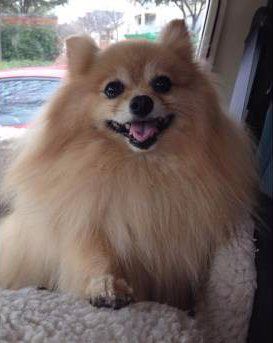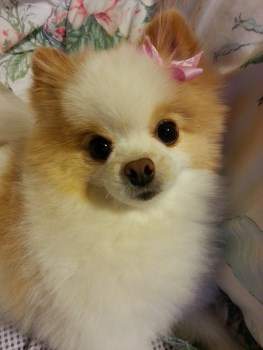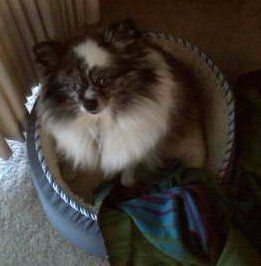Pomeranian Pacing
Overview
We've received quite a few emails in the last few weeks from owners concerned about the amount of pacing that their Pomeranian has been displaying.
Let's look at a few of the questions:
My Pomeranian can be acting completely normal and then all of a sudden, she'll begin to pace in the kitchen and act like she's on high alert. Every now and then, she'll cock her head as if she's listening to something, but I've strained my ears and I can't hear a thing. It's not because she wants or needs food or anything like that; my Pom does this when it's not dinner time and offering a snack only distracts her for a moment. Any idea why she does this? It happens several times a week.
Hi, my 6 month old wolf sable Pomeranian has just started a really weird habit. He will let out a bark or sometimes just a whine and then begin pacing back and forth at a moderate speed, looking around a bit as he does this. But he doesn't seem to be looking at any one thing in general. He seems to have his shoulders up, but his hackles are not quite raised. I've actually even thought that maybe the 'wolf' part of his wolf sable coloring may be making him act like a predatory wolf. I don’t have any other explanations, do you know why a Pom would pace like this?

Zooey
Photo courtesy of Lyssa
I'm worried that my teddy bear Pomeranian, that is just 5 lbs. paces the entire time that I'm gone from home, which is normally almost 7 hours, 5 days a week. I know it sounds silly, but I've come home and spied at my dog through the window, and he was pacing. I've done this at least 10 times and watched for different amount of times, and every single time all my Pomeranian does is pace. Obviously, when I open the front door, it stops. He seems really tired when I go in and I'm worried that he's wearing himself out just pacing like that. He might be doing it for hours. Please help.
So, as you can see, there are owners who are concerned regarding how often a Pomeranian paces, if the dog does this too much while home alone and those who are wondering what in the world a Pom is thinking or reacting to when walking back in forth in the same spot. If any of these issues applies to your Pom, you've come to the right place.
In this section we are going to discuss:
- What exactly pacing is
- Reasons why a Pomeranian puppy or older dog will pace
- If pacing can be a bad thing if a dog does this for a long time
- Ways to help your Pom stop pacing, for instances that an owners should step in
- Health issues that have pacing as one of the symptoms
What Pacing Is
All dogs walk around and when confined without a whole room to roam about, therefore they will of course walk around in the same area. So, what is the definition of pacing that makes it different than just walking in a small area? When a dog paces, this is a rhythmic gait done back and forth along the same line; a Pomeranian will essentially walk the same 'path' over and over. Basically from point A to point B, back again and repeated continually. When dogs pace, this is normally done for just about the same distance in either direction; for example 12 steps one way and 12 the next (though of course dogs do not count their steps as some humans do when purposefully pacing). It is more of a subconscious element, as the dog turns around to begin again. When confined to a playpen or gated off area, most dogs will pace within that length and if in a larger area such as a room, a Pom will often walk back and forth for a length of 4 to 8 feet.
It is normally done at the same rate of speed; though there may be times of varying speeds if a puppy or dog becomes tired or if his reason for pacing causes times of increased anxiousness that mounts.
It is this type of back and worth walking that defines pacing and not the actual duration. A dog may pace for just a minute (a good example is if a Pomeranian paces at his owner's feet as dinner is being prepared) or a Pom may pace for hours, which is usually due to stress and we will touch on this issue ahead.
When there is a certain trigger, a Pom may pace at the same time each day or in other cases, it may appear to be random.
Reasons why a Pomeranian Will Pace
There are many causes of pacing; some are nothing to be concerned about and with others, it will be best to make changes to lessen the amount of pacing that a Pom is doing on a regular basis.
1) Excitement -
This is one of the most common reasons, however owners are usually quite aware if their puppy or dog is pacing due to being excited. There is often something going on… dinner is being made, the dog knows that it is time for a walk and the owner is getting dressed, etc.
2) Excitement mixed with stress -
A Pomeranian may begin to pace if he is being introduced to an element that is exciting but also makes the dog a bit nervous. This can be a place (such as a new dog park) a thing (an introduction to an unfamiliar dog) or a person (a visitor has come to the home and while the Pom is happy with the excited vibe, he is also on alert and a tad nervous).
This all plays back into the need to provide supportive socialization training. Whether a Pomeranian is shy or afraid, a gradual introduction to people, animals, places and situations will allow the puppy or dog to slowly become accustomed to these things… and after a while, they are no longer perceived as 'new'.
The 3 most important keys are: 1)
for an owner to send out a matter-of-fact vibe (in both voice and body language) that relays that there is nothing to be concerned about 2)
Sessions of interacting with the new element are kept short and then are given gradual increases of duration and 3)
the Pomeranian is never forced into a situation that causes stress. Showing your Pom about the world and letting him learn about all of the things that it holds should be a fun and educational. When a dog is allowed to investigate and learn at his own pace, he copes much better than if forced to deal with something that is outside of what he is ready for.
If a Pomeranian is pacing, whining and otherwise acting as if he is overly stressed when in new circumstances, it is best to go back a step in socialization training... or if socialization is not being done, pacing in that way is your clue that your Pom really does need things to be at a slower pace that he can better absorb in small steps.

Princess, 4 years old
Photo courtesy of Helen
3) Triggered Alert Response
- While it can sometimes be difficult to remember this, our cute fluffy Pomeranians are true canines with centuries of canine instinct build into their little bodies. Poms have super keen senses just like any other dog and can hear things 4 times the distance as we can. They also hear sounds at lower frequencies and at higher frequencies than us.
In many cases of a Pomeranian pacing back and forth when an owner is home, and this includes when he tilts his head to the side at intermittent times, this is because the puppy or dog is hearing something that the owner is not able to sense. This can range from a woodland creature out in the tree line (squirrel, raccoon, rabbit, etc.) to other dogs several streets away or even if a bird lands on the roof.
We had someone contact us that after living in her home for over 2 years and her Pom having times of pacing near the back slider on and off most often done each spring and each fall without any seemingly any cause at all, it was discovered that a farm (complete with a bunch of cows) was situated some ways behind her house. She then heard from neighbors that the cows were often led to a nearby pasture (unseen from her view) each spring and fall. Other dog owners let her know that their dogs also paced when the cows were closer than normal.
So, basically, many Pomeranians will pace in response to something that puts them on alert. If another animal of any sort is close enough to the home for them to sense it, it triggers a territorial response that puts them a bit on edge and causes them to pace. This sort of pacing normally does not last very long. A Pom will pace and listen… and after a while, the dog will decide that whatever he has noticed does not present a threat and will go back to doing something else.
4) Separation Anxiety stress -
This is one of the most troubling reasons since leaving a Pom home alone is can be stressful for both a dog and his owner. This can affect a Pom of any age, can develop no matter how short or long he is left on his own and is most often seen in single-pet households.
This goes way beyond a dog simply missing his owner; separation anxiety is a real condition in which there is overwhelming stress due to feelings of isolation. The most common signs of this include: continual barking, pacing (sometimes for hours), frantic behavior, trying to escape, excessive drooling, whining, loss of bladder and/or bowel control and/or Coprophagia (eating feces).
While you often cannot change the fact that you need to leave your Pom alone while you are away at work, there are things that you can do to help. Where you keep your pup, the use of lights, the right toys and even safe calming supplements are all aides that can work together to keep a dog's stress level lower. You may wish to read more: Separation Anxiety.
5) Having to urinate -
Sometimes owners of puppies expect a Pom to have a certain signal that he needs to go to the bathroom, but the dog does something completely different. For example, an owner may expect the Pom to bark or paw at the door, but the pup whines a bit and paces instead. In regard to older dogs, these are those that will change their signal as they mature and this can catch owners off-guard at first. The dog may whine or make other noises while doing this. When in doubt, bring your Pom to his/her bathroom area and you may just find out that their pacing was indicative of needing to pee or poo.
6) Nervous anxiety / compulsion -
Unlike separation anxiety, this is a generalized disorder in which a dog will feel stressed, nervous and anxious much of the time. Due to these feelings, a dog may nervously pace or spin in place. Some will also hide under the bed or otherwise act frightened when there are no threats. Nervous pacing may be done alone with whining or other sounds of distress.
This is much more common with rescued Pomeranians that may have had past trauma and emotional and/or physical neglect. And it is also more common for a young puppy to be afraid than it is for an adult; though senior Pomeranians may develop behaviors including pacing as they age. With seniors, it is typically hearing and/or vision loss that leads to feeling antsy, though certain health issues may cause a dog to pace. You may wish to read more: : Caring for a Rescue Pomeranian
7) Mating urges -
In regard to un-neutered males or un-spayed females, an overwhelming urge to mate can cause the dog to act antsy which includes an energized pacing and wanting to escape from the house. This is more common with males since it may happen at any time at all and they can sense a female in heat up to as much as 3 miles away under the right conditions. With females, this behavior may manifest during the heat cycle
when she is fertile. Having your dog neutered or spayed is beneficial to the dog's health. It drastically reduces or eliminates the chances of developing several types of cancer, can stop marking behavior, reduces territorial behavior and of course stops possible unplanned pregnancies.
8) Health issues -
Sometimes it can be tricky to know for sure if a Pom is ill if there are no clear signs such as vomiting or diarrhea and or if a Pom is injured if there are no clear indications such as limping. However, whenever a dog of any age has a moderate to severe change in behavior, health issues should always be considered until ruled out by an experienced veterinarian. It is not uncommon for a dog to feel vulnerable when ill or injured. This can manifest as retreating, hiding, whimpering, reluctance to play, be touched, eat or exercise
and/or pacing.
When a dog paces along with heavy panting, excessive whining and/or drooling this can point to severe distress including but not limited to stomach upset or partial or full stomach blockage, which is considered a life-threatening condition.
Health Issues in Which Pacing is a Symptom
Aside from the above mentioned internal blockage, there are some other health conditions that while rare, do have pacing as one of the symptoms. This is most often the case in the early stages of the following diseases:

Kaci, 7 years old
Photo courtesy of Ross & Dee
Liver disease -
When the liver is damaged or diseased, it is unable to filter toxins from the body and this can lead to a buildup of ammonia that can then in turn cause some very odd mood and behavior changes. This includes pacing, circling, pressing the head into surfaces such as walls or floors, confused behavior and/or trouble focusing. Other symptoms include loss of appetite, vomiting, diarrhea, increased thirst, yellowed eyes, lethargy and/or blood in the urine. In later stages, a dog may suffer from seizures.
Cushing's disease -
With this condition, there is excessive cortisol in the body. This can lead to many of the same issues as listed above such as pacing and circling. Other symptoms include thinning hair, dry hair, distended stomach, weakness or notable lethargy, excessive thirst and frequent urination.
Canine Cognitive Dysfunction -
While senior Pomeranians will have behavior that is different than their younger counterparts such as a general slowing down, lower heat and exercise tolerance, decreased hearing and/or vision and perhaps a decreased appetite to some extent, other moderate to severe changes in behavior should not be automatically accepted as part of old age. Senior dogs can develop Canine Cognitive Dysfunction which is the canine equivalent of Alzheimer's disease.
Along with aimless pacing, other signs include seeming to be lost in the house (unable to find their way out from behind furniture, etc.), not responding when their name is called, withdrawn (not wanting to interact, play or go for a walk), shaking, loss of bladder and/or bowels, changes in sleeping patterns, staring at inanimate objects, becoming startled very easily and/or changes in eating that affect weight.
Advances are being made in regard to treatment. A medication called L-deprenyl may work for some older dogs to help them think more clearly and focus better.
Brain Tumor -
This is very rare, however must be mentioned since repeated pacing and other repetitive behaviors are one of the possible symptoms. Other signs may include weakness, irritability, circling, forgetting past learned behaviors (house training, commands, etc.) and/or partial facial paralysis in some cases.
Summary
Short acute instances of pacing are normal, since this is an expected canine behavior that is often displayed due to excitement or heightened sense. However, repeated pacing can be due to anxiety or a health condition. If there are no clear reasons such as separation anxiety or when in doubt and even if pacing is the only symptoms, it is always best to have a Pomeranian be evaluated by an experienced and reputable veterinarian.

Find Out Your Pom's Chinese zodiac sign; it is based on his/her year of birth.



